Welcome to Camping Guide
Camping France Article
 . For a permanent link to this article, or to bookmark it for further reading, click here.
. For a permanent link to this article, or to bookmark it for further reading, click here.
You may also listen to this article by using the following controls.
Cooking with Camping stoves
from:For many of us, itís hard to imagine camping without a campfire. But unless you need it for heat, you might not need to go to the trouble of building one anymore. This is because camping stoves have gotten to a point that they are so small, safe, and easy to use that you just might choose their small, useful cooking power over that of a campfire. Not to mention the fact that in many campsites and national forest campgrounds, campfires are considered safety hazards and are prohibited. So camping stoves are a great substitution for your cooking needs in those cases.
Camping stoves, or portable stoves, are designed to be compact and lightweight in order to make them convenient and easy to carry. There are four basic categories of camping stoves, depending on the type of fuel that the stove uses. The most basic stoves are single burner stoves that donít have any controls on them. They use a solid or liquid fuel that is put in the burner before it is lit. Other stoves have single burners as well but instead use a liquid fuel that is compressed into a tank, the top of which is the burner mechanism. Still other stoves use gas. They have one or more burners and also have controls to regulate the amount of gas being burned and the height of the flame, just like a gas stove in your kitchen. The last kind of stoves use spirits that drip down into the priming pan due to gravity. They actually have mostly been replaced by gas stoves because they are easier to transport, but these stoves also have a very low risk of causing a fire.
One of the problems with camping stoves is that their flames are vulnerable to the elements Ė particularly wind. Even if the wind doesnít completely extinguish a burnerís flame, it could cause it to decrease in size or to become uneven in itís placement against the cooking vessel, either of which would reduce the effectiveness of the stove. So when looking at camping stoves, youíll want to consider whether or not a model has a built in wind shield. You may have to purchase a slightly larger (or less collapsible) model in order to get this feature, but it will help reduce frustration when youíre actually cooking with it. Many campers will try to create their own wind shield, a practice that can be very dangerous. If the wind changes directions or strength, the material being used might get blown against the burner flame and ignite. However, aluminium foil is a relatively safe material that can be used to shield if needed.


